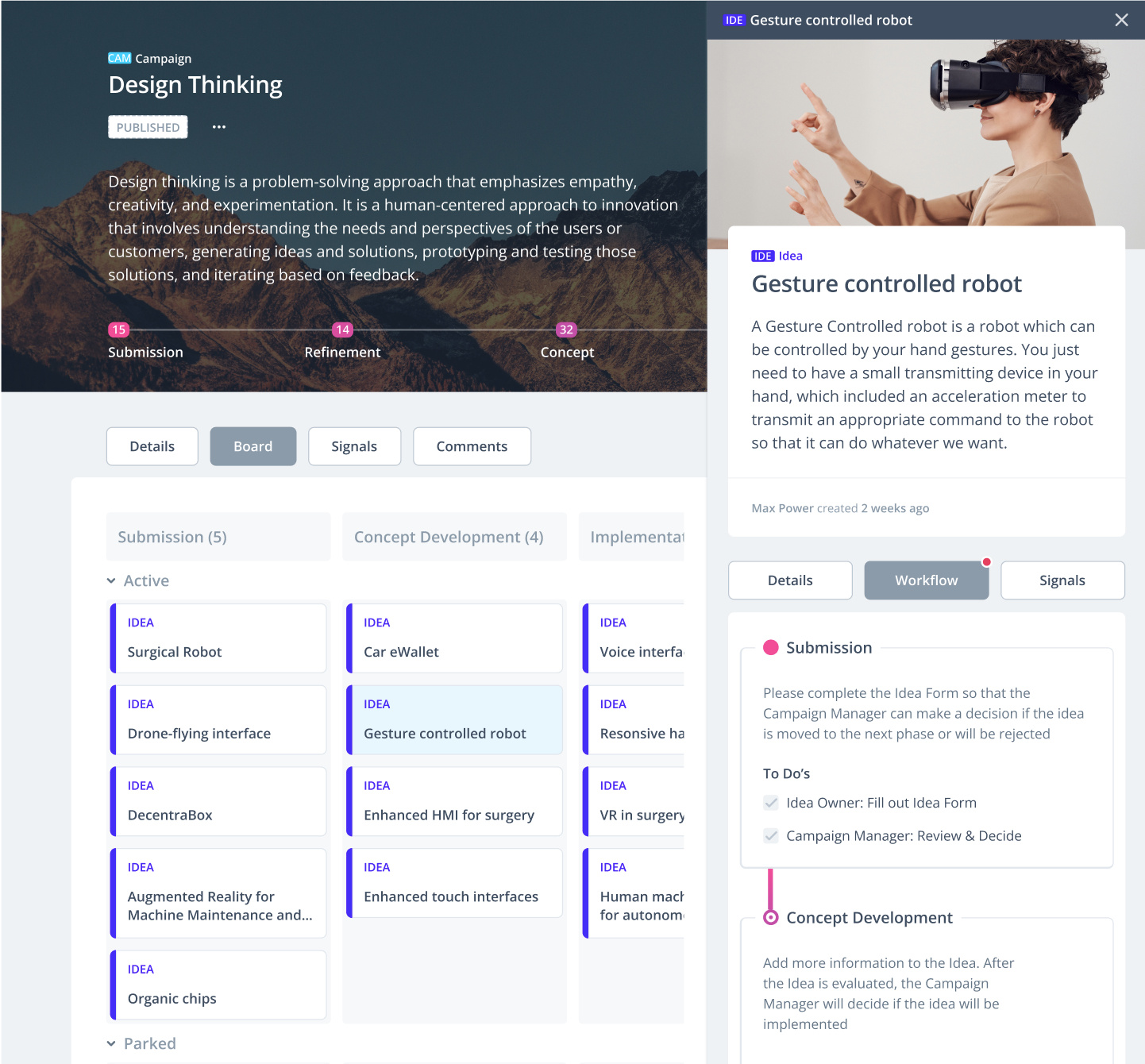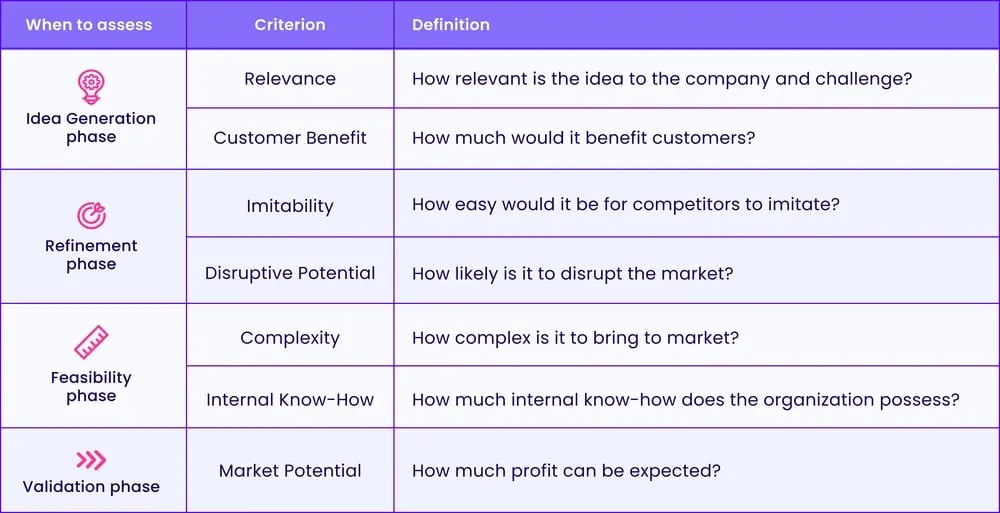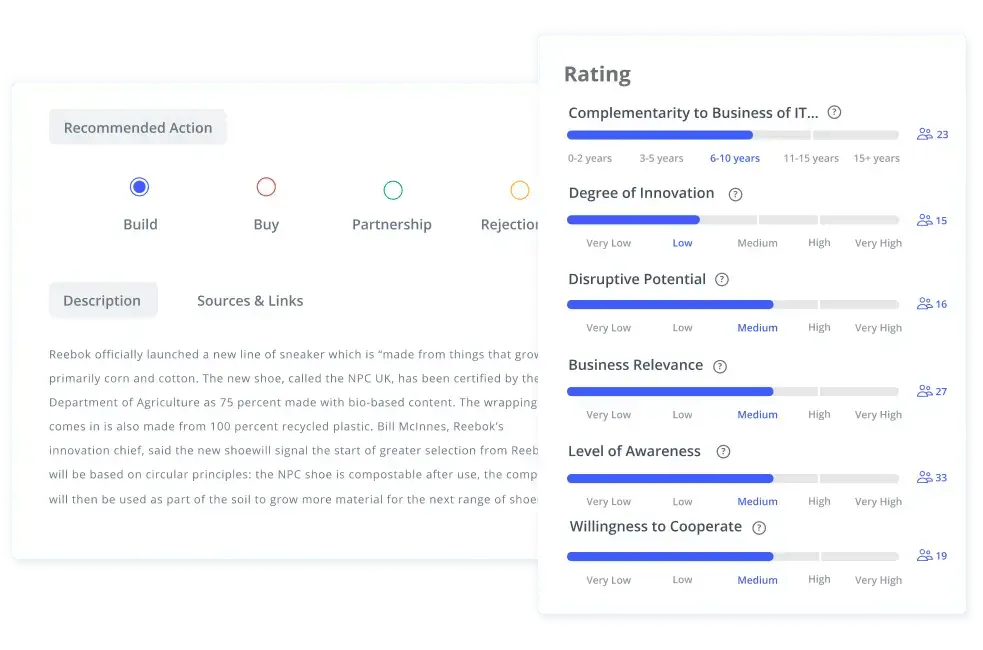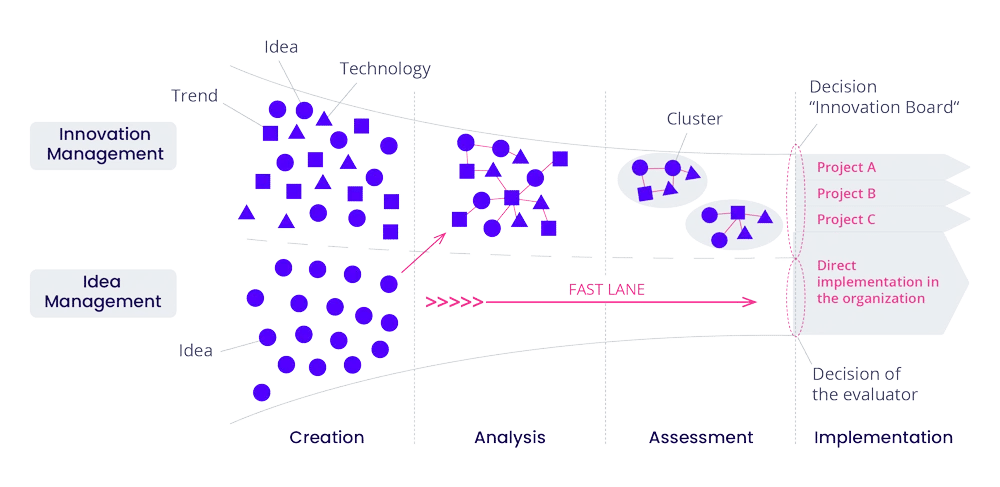Over 95% of ideas fail to nail expectations or never make it to market, not because they lack potential, but because they lack process. That’s why organizations need a systematic idea process to filter, refine, and accelerate only the most promising concepts.
A well-designed innovation funnel, guided by a clear stage gate process, helps teams evaluate ideas at each step, reducing risk and aligning innovation with strategy. In this article, we explore how to build an effective idea process funnel, from defining campaign types to setting evaluation gates, so you can turn more ideas into actionable, high-impact projects.
.webp?width=827&height=663&name=effective-idea-management-3%20(1).webp)
Short answers and FAQs on idea processes
How is an idea process different from an innovation process?
While both are similar, an idea process funnel typically focuses on the early stages of innovative concept, idea intake and evaluation. The innovation funnel often spans the full lifecycle, from market opportunity discover, idea processing and selection to market launch and beyond.
What are the main stages and gates of an idea process?
The main stages are: idea intake, concept definition, experimentation, and full-scale launch.
Each stage is followed by a corresponidng gate that evaluates the stage outcome. The main gates are: initial fit screening, business case attractiveness, technical feasibility, customer adoption and scaling.
To complement the idea process, it is best to define prior to the idea intake the challenge that idea submissions should respond to and solve. This helps with better categorization and often results in multiple idea processes that are run in parallel.
Main classification criteria of idea processes are: internal vs. external campaign, aspired business outcome (e.g., cost optimization, growth, process improvement), or target audience.
Who should be involved in gate decisions on ideas?
For each gate and criteria, it is best to include experts from different departments, each having the knowledge to adequately assess the idea from the perspective of interest.
For instance, customer-facing teams can best evaluate customer desirability, whereas technical feasibility is best evalauted by technical experts.
What criteria should I use to evaluate ideas?
Common criteria include: strategic fit, customer desirability, technical feasibility, ROI potential/viability, and scalability.
Can I use software to manage ideas?
Yes, ideation platforms like ITONICS, Brightidea, or HYPE help centralize idea capture, scoring, collaboration, and tracking across stages and gates.
What is an idea process managed by a funnel?
An idea process managed by a funnel is a structured approach to turning new ideas into innovation projects. It guides ideas through specific phases, from idea generation to concept development, testing, and full-scale launch. Each stage is followed by a gate or decision point, where ideas are evaluated based on set criteria.
The funnel helps filter out weak projects early. Only the best ideas, those with strong business rationale, customer focus, and technical feasibility, move forward. This avoids wasting resources and ensures continuous improvement in how ideas are selected and developed.
By using a systematic approach, organizations can prioritize ideas that align with strategic goals and customer needs. The process often involves cross-functional teams that bring in diverse perspectives. This makes idea screening and gate outcomes more reliable and aligned with success criteria.
Why a structured idea process funnel builds a strong business case
A well-designed idea process strengthens the business case for innovation. By breaking the process into clear stages, such as the scoping phase, testing phase, and development stage, it becomes easier to assess each idea’s potential impact. Each gate helps refine the idea and build up the business case step by step.
The business rationale becomes more robust as data points, customer interviews, and feasibility studies are added. Risk is reduced because decisions are made using real evidence, not gut feeling. This helps project teams secure stakeholder buy-in and budget allocation.
Ultimately, the structured approach connects innovation strategy with execution. It ensures only viable, customer-centric ideas move forward. This alignment turns raw ideas into product innovation with measurable results.
How does idea management integrate with the entire innovation funnel
Idea management is the engine that drives the innovation funnel. It tracks how new ideas move through each project phase, from initial concept to full-scale launch. This visibility helps teams stay on the same page and maintain momentum.
Effective ideation connects idea generation, data-driven evaluation, and resource allocation. Tools like ITONICS or other innovation platforms support structured workflows and streamline decision-making at each stage gate.
When integrated properly, idea processes support continuous improvement. It turns the innovation funnel into a repeatable, scalable process. And it ensures that every brilliant idea has a fair chance to become a business success.
What are the components of a structured idea process funnel
A structured idea process funnel is a repeatable system that drives innovation from idea to new product or service launch. The core components include defined stages, phase gate decision points, evaluation criteria, and tools for ideation. Together, they ensure only the most promising ideas are developed into real innovation projects.
Each stage in the funnel corresponds to a step in the innovation process: idea intake, concept development, business case creation, testing, and implementation. At the end of each stage is a phase gate. These gates act as decision points where ideas are assessed for strategic fit, technical feasibility, and market potential.
This systematic approach gives project teams clarity and structure. It supports continuous improvement by allowing weak projects to be stopped early. At the same time, it allows successful ideas to scale with confidence and alignment.
Classification criteria easing the ideation phase gate reviews
To manage a high volume of new ideas, you need a clear classification system. Classification criteria help structure the ideation stage and make phase gate reviews faster and more consistent. These criteria often include campaign type, strategic goals, customer needs, and idea maturity.
For example, ideas can be grouped by business objective: cost reduction, customer acquisition, or product innovation. They can also be filtered by target audience, whether they come from internal employees, customers, or external partners. This structure enables reviewers to quickly prioritize ideas that align with business strategy.

Well-defined classification also improves decision-making at innovation dashboards. Reviewers can filter out ideas that don’t match campaign goals or that duplicate existing projects. This improves idea screening quality and reduces review time.
Phase gate process components reflecting the innovation process
The phase gate process mirrors the key stages of the innovation process. It breaks the journey into steps with clear outcomes: idea intake, concept definition, development stage, and final implementation. Each gate is a checkpoint to assess progress and viability.
Gate outcomes depend on the criteria set in advance. These include business model strength, development team readiness, technical feasibility, and customer desirability. Each outcome can lead to a go, kill, hold, or recycle decision.
A strong phase gate process includes structured gate meetings, scoring tools, and clear responsibilities for gate reviewers. Involving multiple stakeholders, especially from cross-functional teams, improves the quality of assessments. It ensures the entire project plan remains aligned and reduces bias in evaluation.
Communities filling the innovation funnel
A healthy innovation funnel relies on engaged communities to provide a steady flow of innovative ideas. These communities can include internal employees, cross-functional experts, customers, and even external partners or suppliers. They help fill the funnel with diverse and valuable insights.
Running targeted innovation campaigns or sharing calls for ideas within these communities boosts participation. It encourages people to share ideas aligned with the business strategy and market research insights. Focus groups and customer interviews can also uncover unmet needs that drive strong idea development.
Digital platforms play a big role in managing these communities. Tools for collaboration, sharing, and feedback support a transparent and motivating environment. This keeps your innovation funnel dynamic and relevant, powered by the people closest to real problems and opportunities.
Reviewers and meeting types selecting the best ideas
Selecting the right projects in an innovation funnel depends heavily on having the right reviewers and decision-making structures. Most companies use a stage gate model where each gate includes a review meeting. These meetings bring together cross-functional reviewers, such as R&D, marketing, finance, and operations, to evaluate whether an idea should move to the next phase or be sent back to a previous stage.
Each reviewer brings a unique perspective to assess the unique benefits of an idea, its strategic fit, and feasibility. These discussions ensure that decisions are balanced and data-informed, not based on individual bias. Reviewers use defined criteria and scoring frameworks to help filter and prioritize the best ideas for the next stage of development.
Effective gate meetings include a visual representation of the funnel, stage progress, and key metrics. This clarity supports alignment across teams and speeds up decision-making. Structured review cycles help organizations build a strong, actionable innovation portfolio over time.
Idea software supporting innovation funnel execution
To scale innovation successfully, most companies rely on specialized idea software to support execution across the entire innovation funnel. These platforms help manage the process from idea submission through each stage gate, providing structure, transparency, and collaboration.
Software tools allow teams to define gate criteria, assign reviewers, and track outcomes for each phase. With built-in dashboards, teams can visualize the flow of ideas and pinpoint where delays or drop-offs happen. This helps keep innovation moving and ensures that the right ideas reach implementation.

By supporting every next stage with automation and clarity, software ensures consistency and visibility. It also makes it easier to compare ideas, identify gaps, and build a pipeline of innovation that delivers measurable business results.
Key stages and gates of the best ideation funnel
A high-performing ideation funnel follows a structured stage gate process, guiding ideas through evaluation and development with discipline and clarity. This stage gate model is essential for managing risk and ensuring only the most promising ideas advance. Whether you're running internal campaigns or tackling complex projects, the right structure keeps your innovation engine running smoothly.

Most successful product development projects use a version of the phase gate process, typically broken into five phases, from idea collection to final launch. Each phase ends with a gate, where cross-functional teams evaluate whether the idea should move forward based on clearly defined criteria. This structured decision-making is especially important when team members work across multiple departments and time zones.
Preliminary definition of the idea campaign types
Before starting the first phase, it’s crucial to define the idea campaign type. Campaigns can be open (company-wide) or targeted (e.g., focused on sustainability or cost savings). They may be internal or external, depending on the focus areas and innovation goals.
Defining the campaign type helps structure idea intake and simplifies evaluations later. It also determines which teams will review submissions and which key assumptions should be tested. This front-loading saves time during review and avoids misalignment during the stage gate process.
Stage 1: Idea collection and idea generation
The funnel begins with idea collection, where employees, customers, or partners are encouraged to share raw ideas. This stage focuses on quantity and openness. Digital platforms and campaigns make it easier to reach large communities and capture ideas that might otherwise go unnoticed.
At this point, it’s important to encourage creativity without over-filtering. However, good funnel design still provides categories or tags to classify ideas by topic, goal, or department. This enables faster processing at the first gate and helps reviewers spot relevant entries among similar ones.
Gate 1: Duplicate check and campaign fit check
The first stage gate acts as a filter to ensure ideas are original and relevant to the campaign. Reviewers perform a duplicate check to avoid redundancy and a campaign fit check to confirm the idea addresses the intended challenge or objective.
Criteria at this gate often include:
-
Strategic fit
-
Novelty
-
Alignment with focus areas
Outcome options include:
-
Accept for further concept definition
-
Refine and resubmit
-
Reject and archive
This gate is typically fast-paced and handled by a smaller team. The goal is to filter efficiently, not to fully evaluate the idea’s business value yet.

Stage 2: Concept definition and market research
In this stage of the funnel, selected ideas are shaped into more detailed concepts. Teams define the idea’s core value proposition, potential users, and how it addresses real customer needs. Alongside this, early market research helps validate assumptions and explore competitive or technological landscapes.
This phase requires more structured input from team members, often involving product development projects or customer-facing departments. It’s where ideas move beyond abstract suggestions and start to take shape as potential business solutions. Capturing key assumptions here—like target audience needs or usage context—is essential for accurate evaluation at the next gate.
Gate 2: Evaluation of business rationale and desirability
Gate 2 of the stage gate model determines whether the idea has enough merit to move beyond business case development. This stage gate is more rigorous than the first and typically includes multiple reviewers from marketing, finance, and operations.
Criteria include:
-
Customer desirability (Is this solving a real, urgent problem?)
-
Urgency (Is now the right time to act on this?)
-
Development budget (Are resources available or justified?)
Outcome options are:
-
Proceed to development,
-
Refine the concept,
-
or reject if risks outweigh the benefits or if it lacks alignment with goals.
Stage 3: MVP and development stage
At this stage of the stage gate process, the concept becomes real through the creation of a minimum viable product (MVP) or early prototype. The goal is to test the core functionality, gather feedback, and validate that the idea works in practice. This is especially important for complex projects or product development projects where risk and resource requirements are higher.
Teams focus on building and iterating quickly, using real data to refine their assumptions. Feedback from users, stakeholders, or test markets provides input for potential improvements. This stage gate process ensures that only technically sound, strategically aligned projects proceed to scale.
Gate 3: Assess feasibility gate outcomes
Gate 3 of the stage gate model is all about assessing feasibility and determining if the idea is ready for broader development or launch. It’s a critical checkpoint where team members work together to evaluate technical progress, user response, and resource alignment.
Criteria include:
-
Technical readiness (Is the solution stable and scalable?)
-
MVP success (Did it perform well in real-world conditions?)
-
Budget fit (Are further investments justified?)
Outcome options:
-
Greenlight pilot/launch,
-
Adjust scope,
-
Or stop the project if it doesn’t meet performance or strategic expectations.
Stage 4: Implementation and scalability
In the phase gate process, the focus shifts from validation to execution. This stage covers the rollout of the solution, often starting with beta testing to gather final feedback before full launch. For large projects, this phase also includes preparing a go-to-market strategy and aligning cross-functional teams.
Project management plays a key role in coordinating project plan delivery, ensuring readiness across product, marketing, and operations. A strong marketing campaign often accompanies launch efforts, helping to drive adoption and awareness. The goal is to ensure a seamless transition into the next phase of commercialization or scaling.
Gate 4: Customer adoption review and launch decision
This final stage gate determines whether the idea is ready for full rollout or needs further iteration.
Criteria include:
-
Market readiness
-
Team alignment
-
Delivery capability
Outcome:
-
Launch,
-
Delay,
-
or pivot depending on feedback and rigorous testing results from earlier project phases.
Stage 5: Post-funnel integration into product and service catalogues
Once an idea has passed all stage gate reviews, it enters the final step, integrating into existing product or service catalogues. This phase involves coordinating with project management teams to align delivery timelines and resource planning. A targeted marketing campaign supports launch visibility, while insights from competitive analysis help position the solution effectively.
/Videos/HiFi-Animation-Portfolio-Monitor-Portfolio-Health.webp?width=1190&height=714&name=HiFi-Animation-Portfolio-Monitor-Portfolio-Health.webp)
Successful integration ensures the innovation delivers a lasting impact and informs future projects. Capturing lessons learned strengthens the overall innovation funnel by feeding back knowledge into earlier stages. This continuous loop supports smarter, faster innovation over time.
4 proven examples of innovation phase gate processes
Real-world success stories show how companies use the stage gate process to bring clarity, speed, and structure to innovation. These organizations have optimized their innovation funnel using ITONICS, proving how digital tools and disciplined workflows can drive results across industries.
DB Schenker: Streamlining the flow of innovation
DB Schenker needed to coordinate innovation across global teams. By implementing a standardized stage gate approach within the ITONICS platform, they simplified project management and enabled real-time decision-making.

Ideas were moved seamlessly from submission to execution, creating a visible and efficient innovation funnel.
KPMG: Leveraging AI and human idea generation
KPMG combined artificial intelligence with human insight to power idea discovery at scale. Using ITONICS, they filtered high-potential ideas through a structured phase gate process, blending trend-based scouting with expert evaluation.
The result: better-informed project selection and a more agile project plan aligned with strategic goals.

Dish: Turning ideas into action
Dish Network shifted from informal ideation to a robust, measurable stage gate process. With ITONICS, they tracked ideas through each project phase, using defined gate criteria and reviewer roles to ensure fast, fair evaluation.
This structure helped turn more ideas into active, value-generating projects.

Cisco: Innovate everywhere challenge
Cisco’s global innovation campaign brought thousands of ideas into a single platform. The structured stage gate model helped sort, evaluate, and scale ideas, connecting employees worldwide in a transparent, collaborative process.

The initiative drove cultural change and created a repeatable innovation framework with clear project management milestones.
Run a convincing idea process today. With the best idea software.
The ITONICS Innovation OS is the most comprehensive platform designed to capture, share, and bring valuable ideas through systematic phase gate processes to production. With ITONICS, you can harness the full potential of ideation in a single, user-friendly system. Ensure your best ideas move beyond brainstorming sessions and turn into actionable innovations.

Streamline ideation: Managing a high volume of ideas from various sources can be overwhelming. ITONICS allows you to capture, evaluate, and prioritize ideas from across the organization, including customers and partners, all in one structured stage gate process. This helps focus resources on the most impactful ideas and reduces time wasted on less promising ones.
Drive continuous improvements: Equip your organization like professional athletes and foster everyday improvement. Provide one central place to collect any idea, identify patterns, and get things done. Use transparent communication to implement routines and a sense of “each day better”.
Accelerate time-to-market: Gain unprecedented efficiency in innovation. The ITONICS Innovation OS saves time, reduces efforts, and accelerates time-to-market. When speed matters and time is money, reducing any administrative burden is what lets innovation leaders excel.







